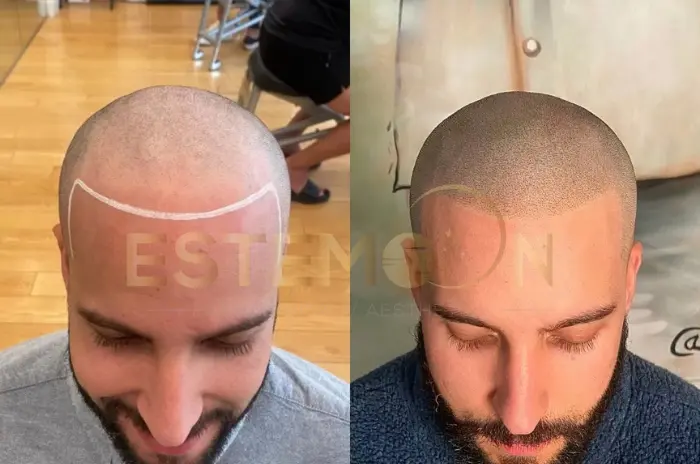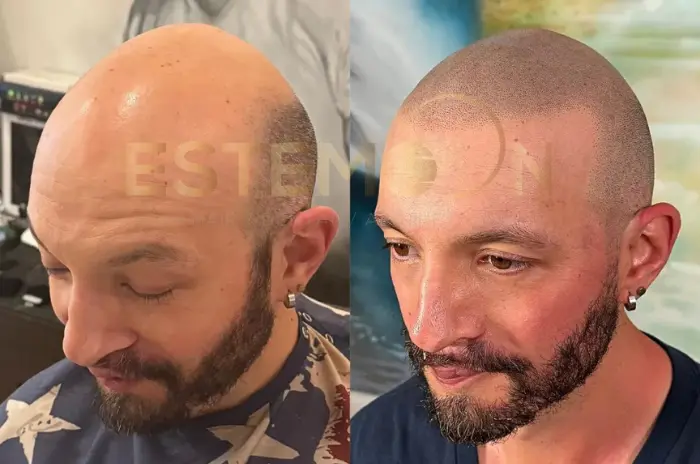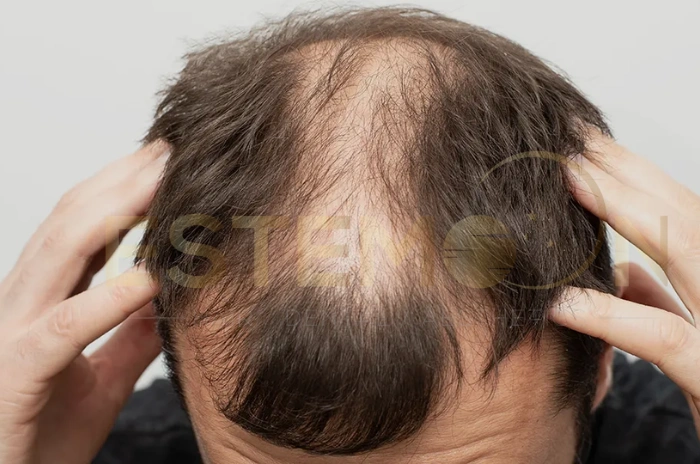Hair tattooing, also known as scalp micropigmentation (SMP), has emerged as one of the most popular non-surgical hair restoration options for men facing hair loss. This method is gaining attention globally, especially when comparing hair tattoo vs hair transplant, which are two distinct solutions. While transplants involve surgery and actual hair growth, tattoos offer an illusion of fuller hair through pigmentation.
In this guide, we’ll explore everything from the advantages and limitations of hair tattoos to their long-term care, ensuring you make an informed decision.

What are hair tattoos?
A hair tattoo is a cosmetic procedure where natural pigments are deposited into the scalp using micro-needles. This mimics the appearance of hair follicles, giving the illusion of a fuller head or a closely-shaved scalp. The technique, commonly referred to as scalp micropigmentation, is non-invasive and offers immediate results.
Unlike traditional tattoos, SMP uses specialized equipment and pigments designed for the scalp. It is an effective option for men who want a sharp, buzz-cut look without undergoing surgery. It can also be tailored to match your hair color and skin tone for a more realistic appearance.
Hair Tattooing for Men: Pros and Cons
1. Results May Not Be Natural
The appearance depends heavily on the skill of the practitioner.
Poorly done procedures may look artificial or patchy.
It doesn’t have the texture of real hair.
Lighting conditions can also affect how realistic the results appear.
2. It Can Be Costly
Quality procedures are expensive, especially in large cities.
Costs increase with touch-ups and maintenance.
It’s often not covered by insurance.
Long-term care may require budgeting for periodic enhancements.
3. Complications May Occur
Risk of allergic reactions to pigments.
Possible infections if hygiene standards are not met.
Rare pigment migration under the skin.
Professional aftercare reduces these risks significantly.
4. It May Not Work with Long Hair
SMP is most effective with a shaved or closely-cropped hairstyle.
Blending with longer hair is difficult.
Not ideal for men wanting to grow their hair.
Creates a mismatch if the natural hair is grown out.
5. It Doesn’t Grow Real Hair
No actual hair regrowth occurs.
It’s purely cosmetic.
Not a regenerative treatment.
It’s a visual solution, not a biological one.
6. It Can Take a While
Usually requires 2-4 sessions.
Each session lasts several hours.
Healing time varies between individuals.
Results become more natural-looking after full healing.
7. It’s Not Actually Permanent
Fades over time, especially with sun exposure.
Requires touch-ups every 2–5 years.
Maintenance can add up in the long term.
Some clients may need more frequent touch-ups depending on lifestyle.
8. Tattoo Removal Can be Costly and Painful
Laser removal is expensive and uncomfortable.
Complete removal may not be possible.
Risks of scarring during removal exist.
Always choose an experienced SMP technician to avoid regrets.
Which men make good candidates for a hair tattoo?
Hair tattoos are best suited for men who are experiencing thinning hair or small bald spots but still have some hair to blend with the pigmentation. They are also ideal for individuals who prefer a clean-shaven or buzz-cut look and are not looking for surgical intervention. Those who have medical conditions such as alopecia or who are not eligible for a hair transplant in Turkey or elsewhere can also greatly benefit from this method.
Men with thinning hair looking for density.
Those who prefer a shaved look.
Individuals who are not suitable candidates for a hair transplant in Turkey or elsewhere.
Men with alopecia or patchy hair loss.
Those wanting a fast solution with minimal downtime.
How successful is a hair tattoo for men?
Hair tattoo procedures have gained a strong reputation for delivering consistent and satisfying results for men with different degrees of hair loss. Many clients experience a significant boost in self-confidence as the procedure improves the visual density of their hair. The outcome is often described as natural-looking, especially when performed by a skilled technician.
Satisfaction rates are high among patients.
Offers a uniform and polished look.
Blends well with existing hair when professionally done.
Reduces the visual contrast between bald and haired areas.
Helps regain confidence in personal and professional settings.
Can a hair tattoo be combined with a hair transplant?
Yes. Many patients opt for both treatments:
SMP enhances the visual density of transplanted hair.
It can mask scars from previous hair transplant in Turkey procedures.
Ideal for areas where transplant results are thin.
Helps create a seamless appearance across the scalp.
Hair Tattoo vs. Scalp Micropigmentation: Understanding the Difference
These terms are often used interchangeably:
Both refer to the same technique.
Scalp micropigmentation is the professional term.
“Hair tattoo” is more colloquial and less precise.
Regardless of the name, the goal is to create a fuller hair appearance.
In essence, there is no technical difference between a hair tattoo and scalp micropigmentation—they are the same procedure described in different ways. The term “hair tattoo” is more commonly used in casual settings, while “scalp micropigmentation” is preferred by professionals. Understanding both names can help you better research clinics and communicate your goals clearly.

Should You Get a Hair Tattoo?
Consider the following:
Are you comfortable with a shaved or buzzed look?
Can you commit to periodic touch-ups?
Do you understand this is not a hair regrowth solution?
Are you seeking a non-surgical hair restoration option?
If yes, SMP may be a fitting choice to explore.
Is a hair tattoo suitable for your type of hair loss?
Hair tattoos are most suitable for men with visible scalp areas due to thinning, receding hairlines, or pattern baldness. Individuals with patchy hair loss or alopecia areata can also benefit, as SMP creates the illusion of density and a defined hairline. However, it is less effective for those desiring longer hairstyles, as the technique is best suited for a close-cropped look.
Works best for men with diffuse thinning.
Suitable for receding hairlines and bald crowns.
Less effective for those hoping to restore long hair appearances.
An evaluation with a specialist will confirm suitability.
Can you get a hair tattoo if you’re completely bald?
A hair tattoo is especially well-suited for men who are entirely bald and want to recreate the look of a full, shaved head. This technique can define the hairline and give structure to the scalp, resulting in a more youthful and well-groomed appearance. It’s a non-invasive way to gain confidence and restore a sense of identity without surgery.
Yes, especially effective for full scalp coverage.
Mimics a natural buzz-cut appearance.
Enhances head shape and symmetry.
Creates a low-maintenance solution for total hair loss.
Can hair tattoos cover scars?
Hair tattoos, or scalp micropigmentation, are an effective method for concealing scars on the scalp caused by injury or past hair transplant procedures. The pigment is matched to your existing hair color and applied in a way that blends seamlessly with the surrounding scalp. This allows the scarred area to become far less noticeable, significantly improving one’s overall appearance and confidence.
Yes, particularly effective for:
FUE and FUT transplant scars.
Injury or surgical scars.
Improves cosmetic appearance significantly.
Helps build self-esteem in scarred individuals.
How much does a hair tattoo cost?
Prices vary based on location and clinic:
| Location | Average Cost (USD) |
|---|---|
| United States | $2,000 – $4,500 |
| United Kingdom | $1,500 – $3,500 |
| Turkey | $800 – $2,000 |
| Australia | $2,500 – $5,000 |
Costs may also include consultation and touch-ups. Packages may vary depending on coverage size and desired style.
Here’s a comparison table of Hair Tattoo vs Hair Transplant to help you visualize the key differences:
| Feature | Hair Tattoo (SMP) | Hair Transplant |
| Invasiveness | Non-surgical | Surgical |
| Hair Regrowth | No | Yes |
| Immediate Results | Yes | No (takes months) |
| Maintenance | Touch-ups every 2–5 years | Minimal after healing |
| Cost | Lower initial cost | Higher upfront cost |
| Suitable for Scars | Yes | Yes, with limitations |
| Downtime | Minimal | Moderate to High |
Costs may also include consultation and touch-ups. Packages may vary depending on coverage size and desired style.

What are the advantages of hair tattoos?
Non-invasive and low-risk procedure.
Instant results without surgery.
Low maintenance compared to transplants.
Can boost confidence and appearance.
Versatile option for different hair loss patterns.
What are the risks associated with hair tattoos?
While scalp micropigmentation is generally considered safe, there are still some risks that individuals should be aware of before undergoing the procedure. Allergic reactions to the pigments, improper sterilization, or untrained practitioners can result in infections, discomfort, or unsatisfactory results. It’s essential to select a reputable clinic and follow aftercare instructions carefully to minimize any potential complications.
Allergic reactions to pigment.
Infection risks if improperly done.
Risk of fading, especially without proper care.
May not meet expectations if done by inexperienced practitioners.
Ensure practitioner certification to minimize risks.
What happens after your hair tattoo treatment?
Scalp may feel tender and red.
Avoid sweating, swimming, and sun exposure for a few days.
Follow care instructions strictly for best results.
Final appearance settles after 1–2 weeks.
Minor scabbing is normal during healing.
Scalp Micropigmentation is the Same as a Hair Tattoo
While some people may assume there’s a difference, scalp micropigmentation and hair tattooing are essentially the same process. The terms are often used interchangeably to describe the cosmetic technique of adding pigment to the scalp to simulate hair follicles. Whether marketed as SMP or hair tattoo, the tools and methods used are identical.
Both involve pigment application to the scalp.
Use the same tools and techniques.
The difference lies in terminology only.
Industry professionals prefer the term SMP.
Hair Tattoos for Hair Transplant Scars
Hair tattoos are a reliable option for men who want to conceal visible scars left by previous hair transplant procedures such as FUT or FUE. The pigments are skillfully applied to match the surrounding scalp and hair follicles, making the scars much less noticeable. This method not only improves aesthetics but also boosts confidence in those who have been self-conscious about their surgical marks.
Camouflages visible transplant scars.
Helps blend scarred areas with surrounding scalp.
Often combined with newer hair transplant in Turkey sessions.
Enhances overall scalp aesthetics.
Disadvantages of Hair Tattoos
1. No actual hair regrowth
Only creates an illusion.
You’ll still be bald to the touch.
No biological stimulation of follicles occurs.
2. Not suitable for everyone
Especially those wanting long hairstyles.
People with certain skin conditions may not be eligible.
Consultation is essential before treatment.
3. Realistic results, but not perfect
Close inspection reveals it’s not hair.
May appear less natural under certain lighting.
Artistic skill of the technician plays a major role.
4. Results aren’t permanent
Regular touch-ups required.
Environmental exposure may accelerate fading.
Lifestyle can influence longevity.
Long-term hair tattoo maintenance and care
1. Protect your scalp from the sun
Use sunscreen or a hat daily.
UV rays can cause premature fading.
Reduces the need for frequent touch-ups.
2. Use moisturiser
Keeps scalp healthy and prevents dryness.
Enhances pigment retention.
Reduces flaking and irritation.
3. Ongoing touch-ups
Maintain color consistency and sharpness.
Typically needed every 2–5 years.
Rejuvenates overall look and depth.
Hair Tattoo Inspiration Styles
1. Geometric Playground
Clean lines and abstract patterns.
Often chosen for artistic expression.
Adds a contemporary edge to your look.
2. Floral Fantasy
Organic and artistic floral motifs.
Great for those wanting a softer, natural vibe.
Works well with symmetrical placements.
3. Tribal Spirit
Culturally inspired tattoo patterns.
Reflects personal heritage or tradition.
Often bold and intricate in design.
4. Celestial Symphony
Star and moon-themed designs.
Symbolizes dreams or spirituality.
Offers a mystical visual statement.
5. Words of Wisdom
Inspirational quotes subtly inked.
Reflects personality or beliefs.
Often located at the back or sides.
6. Glitter Adventure
For bolder personalities, with shimmering accents.
Eye-catching and unconventional.
Best for temporary or creative expressions.
FAQs About Hair Tattooing for Men: Common Questions
What is a hair tattoo and how does it work?
A hair tattoo uses micro-needles to deposit pigment into the scalp to mimic hair follicles.
How long does a hair tattoo last?
Typically 2–5 years, depending on skin type and aftercare.
Is a hair tattoo suitable for all types of hair loss?
It’s best for thinning, bald spots, or a receding hairline but not ideal for restoring long hair.
What are the potential risks or side effects of hair tattooing?
Risks include infection, fading, and allergic reactions to pigments.
How much does a hair tattoo cost?
Prices range from $800 to $5,000 depending on the country and clinic.
Can a hair tattoo be combined with other hair restoration treatments?
Yes, especially to enhance density after a transplant or cover scars.
What is the difference between a hair tattoo and scalp micropigmentation?
They’re the same procedure; the names are used interchangeably.
What is the recovery process after getting a hair tattoo?
Mild redness and sensitivity; avoid sun, sweat, and water exposure for a few days.
Follow us on social media for updates, tips, and patient success stories:




